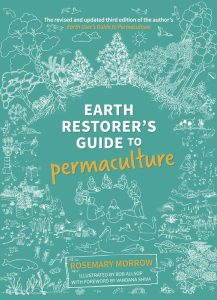‘Love it, know it, save it’ – an interview with Rosemary (Rowe) Morrow
In the Spring of 2022, Ann Stanley had a conversation with permaculture leader, Rosemary Morrow, about local food production, adapting to change in an unpredictable world, and honouring indigenous knowledge.
 You might well be a person who knows about the challenges of growing nutritious food. In your garden, you might be applying permaculture practices such as rainwater harvesting, composting, and working with available sunlight. But did you know that, in refugee camps and other marginalised communities all over the world, people are meeting much greater challenges by applying the same permaculture principles? Rosemary (Rowe) Morrow has taken permaculture to camps and other communities in Iraq, Bangladesh, Afghanistan, and the Philippines (to name a few), teaching marginalised people to grow food under extremely challenging conditions.
You might well be a person who knows about the challenges of growing nutritious food. In your garden, you might be applying permaculture practices such as rainwater harvesting, composting, and working with available sunlight. But did you know that, in refugee camps and other marginalised communities all over the world, people are meeting much greater challenges by applying the same permaculture principles? Rosemary (Rowe) Morrow has taken permaculture to camps and other communities in Iraq, Bangladesh, Afghanistan, and the Philippines (to name a few), teaching marginalised people to grow food under extremely challenging conditions.
I met Rowe in the retrofitted house of her friend in Richmond. She was in Melbourne to promote her re-written book, The Earth Restorer’s Guide to Permaculture (originally published as The Earth User’s Guide to Permaculture), a work that shows us many of the ways that food can be produced locally, with a thorough discussion of the reasons why it should be.
 The updated version takes into consideration the changed world that we live in. Says Rowe, “in 1971, no-one was talking about megacities or about oceans, about refugee camps, pandemics and natural disasters. Since that time, whole villages in India have been lost because of glacial melting.”
The updated version takes into consideration the changed world that we live in. Says Rowe, “in 1971, no-one was talking about megacities or about oceans, about refugee camps, pandemics and natural disasters. Since that time, whole villages in India have been lost because of glacial melting.”
Rowe is a big-picture thinker whose mind ranges freely across a multitude of topics from marine systems to earthworms, and even how you can register your permaculture project with the UN. Thinking globally and acting locally all over the world, advocating traditional methods of working with difficult conditions, she urges us all to see the earthworms in our gardens as well and truly connected to the health of the oceans through vast natural systems. And to understand that our food growing enterprises, including those here in the north-east of Melbourne, are a part of these systems.
From Rowe’s point of view, a productive garden in a refugee camp is based on the same principles as an urban food garden on vacant land in an overcrowded and polluted city or food production in a suburban backyard. All should involve restorative practices in response to climate change and loss of biodiversity and often, especially in the case of displaced people, loss of community and identity. All should involve food production that maximises available water, soil, light and labour and all, ideally, should be infused with the permaculture ethics of ‘earth care, people care, fair share’.
As an example of how interconnected we all are with each other and within the systems of nature, Rowe explains how, in Bangladesh, one million Rohingya people on the move “cut down trees to cook rice, take water out of rivers to make cement for housing and chop down bamboo for housing.” It’s a case of large-scale movement of people being directly connected to the crisis of the natural environment.
Rowe says that, in her experience, “Refugee camps spread permaculture faster than anywhere else. Permaculture Design Courses work there because the camps are boring, people want to work, and all have been made redundant in the process of leaving their livelihoods.”
For those of us lucky to live a more settled existence, it might be interesting to contemplate that, according to Rowe, “All the best work in sustainability around the world is being done at the local council level. It’s a local council-led movement. Cities are becoming cleaning and greener, and we can’t rely on state and national governments. You can see it with the response to natural disasters – it all happens at the local level.”
Despite her optimism, Rowe sees much work still to be done. She has found that in comparison to the Rohingya people in Permaculture Design classes “who could list hundreds of trees and 80 uses for each one“, people in the West are “illiterate and ignorant“. She recommends that each of us go about “seeing and naming” all the species of plant and animal in our own backyards because, “you must know and love your ecosystem (not just individual plants) so that you can protect it.”
On the subject of cities, Rowe speaks with enthusiasm about underground car parks that are turned into chicken homes, high rise buildings with worm farms and built-in water storage, and the possibility of whole urban communities living in vertical villages.
She also believes that “Australia leads the way in regenerative agriculture” and takes hope not only from this but also from the knowledge indigenous Australians still have about how to live sustainably on this climate-challenged continent.
“Indigenous people regenerated the land appropriate to its use, ” she says, whereas the rest of us “change the soil to grow a cabbage“. Rowe would like to see people planting kitchen garden of indigenous plants near their back doors. And she would like Westerners “to learn to distribute surplus better than we currently do, learning from the practices of non-Westerners who do this better“.
In The Earth Restorer’s Guide to Permaculture, Rosemary Morrow says that permaculture design, in the face of our global challenges, while sometimes just ‘palliative’, is “always better than doing nothing. Her final words in the book are a call to action: “Go and make this world a better place, be creative, enjoy and take responsibility for every day of your life.
[Rosemary Morrow began her professional life as a research scientist. She has been an advocate and practitioner of permaculture since 1985. As a Quaker, her interest in sustainability is infused with commitment to peace, simple thinking, ethical behaviour, and care of environment and community.]
Further exploration
Rosemary Morrow, The Earth Restorer’s Guide to Permaculture, Melliodora Publishing, 2022.
Restore the soil: prosper the nation.
